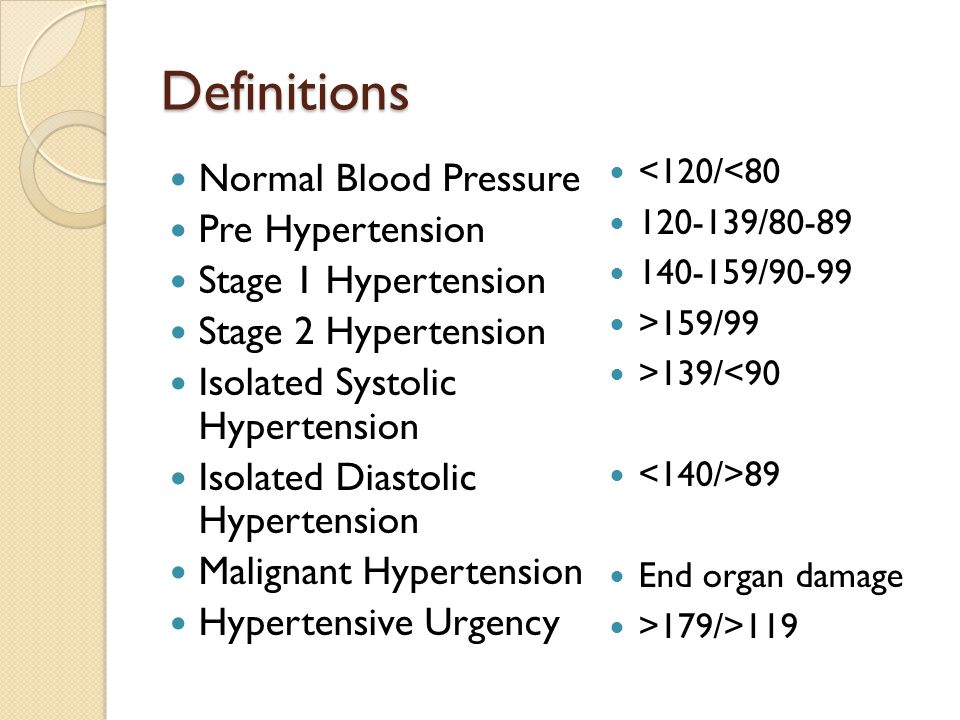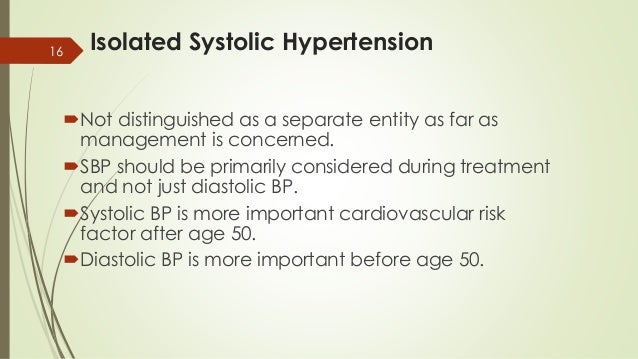Isolated systolic and diastolic hypertension
Isolated systolic and diastolic hypertension
Isolated systolic hypertension happens when your diastolic blood pressure is less than 80 millimeters of mercury (mm Hg) and your systolic blood pressure is 130 mm Hg or higher. Isolated systolic hypertension is the most common form of high blood pressure in people older than age 65
The data so far available indicate that low‐dose thiazide diuretics and slow/long‐acting calcium antagonists are the drugs of first choice. A slow reduction of systolic pressure in the mostly elderly patients is mandatory. A target level of SBP around 140 mmHg seems desirable.



Isolated diastolic hypertension (IDH), defined as a diastolic blood pressure (DBP) > 90 mmHg and a systolic blood pressure (SBP) < 140 mmHg, is a common situation in medical practice. In the elderly, the cardiovascular risk is clearly associated with the level of systolic BP and pulse pressure.try lifestyle changes and dietary measures first for mild elevation.
a study published in AHA jounals shows the treatment pattern ,in that study Most treated participants with IDH reported taking 1 antihypertensive medication in both urban and rural areas . Even though use of combination therapy increased slightly with age, <5% of the participants received ≥3 drugs across all age groups. Most treated participants with IDH reported taking Western antihypertensive medications (9969 or 98%). Among IDH participants using 2 or fewer classes of medications, calcium channel blockers (42%) were the most frequent class of medication used, followed by angiotensin‐converting enzyme inhibitors or angiotensin receptor blockers (20%), and diuretics (7%), respectively . On stratification of IDH patients based on their degree of DBP elevation, we found that the majority (74.7%) had DBP of 90 to 95 mm Hg, followed by 96 to 100 mm Hg (19.6%), and >100 mm Hg (5.7%), respectively. The most frequently used antihypertensive medication class and the number of antihypertensive medications used did not vary significantly between 3 groups (both P>0.05;
Isolated systolic hypertension happens when your diastolic blood pressure is less than 80 millimeters of mercury (mm Hg) and your systolic blood pressure is 130 mm Hg or higher. Isolated systolic hypertension is the most common form of high blood pressure in people older than age 65
The data so far available indicate that low‐dose thiazide diuretics and slow/long‐acting calcium antagonists are the drugs of first choice. A slow reduction of systolic pressure in the mostly elderly patients is mandatory. A target level of SBP around 140 mmHg seems desirable.




Isolated diastolic hypertension (IDH), defined as a diastolic blood pressure (DBP) > 90 mmHg and a systolic blood pressure (SBP) < 140 mmHg, is a common situation in medical practice. In the elderly, the cardiovascular risk is clearly associated with the level of systolic BP and pulse pressure.try lifestyle changes and dietary measures first for mild elevation.
a study published in AHA jounals shows the treatment pattern ,in that study Most treated participants with IDH reported taking 1 antihypertensive medication in both urban and rural areas . Even though use of combination therapy increased slightly with age, <5% of the participants received ≥3 drugs across all age groups. Most treated participants with IDH reported taking Western antihypertensive medications (9969 or 98%). Among IDH participants using 2 or fewer classes of medications, calcium channel blockers (42%) were the most frequent class of medication used, followed by angiotensin‐converting enzyme inhibitors or angiotensin receptor blockers (20%), and diuretics (7%), respectively . On stratification of IDH patients based on their degree of DBP elevation, we found that the majority (74.7%) had DBP of 90 to 95 mm Hg, followed by 96 to 100 mm Hg (19.6%), and >100 mm Hg (5.7%), respectively. The most frequently used antihypertensive medication class and the number of antihypertensive medications used did not vary significantly between 3 groups (both P>0.05;

Comments
Post a Comment